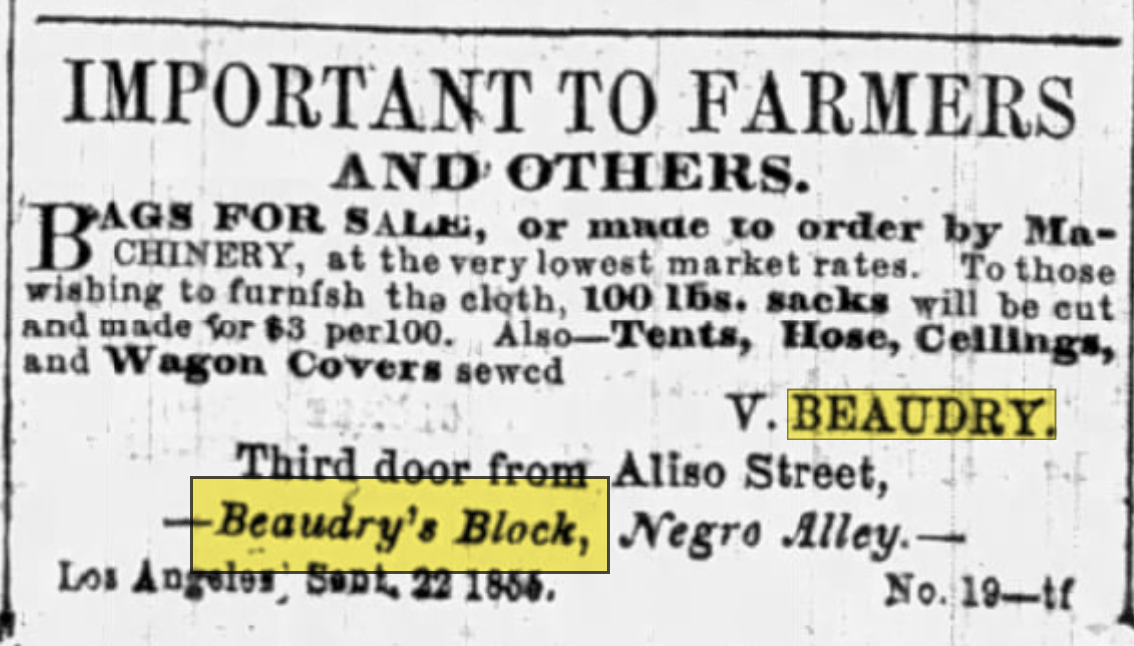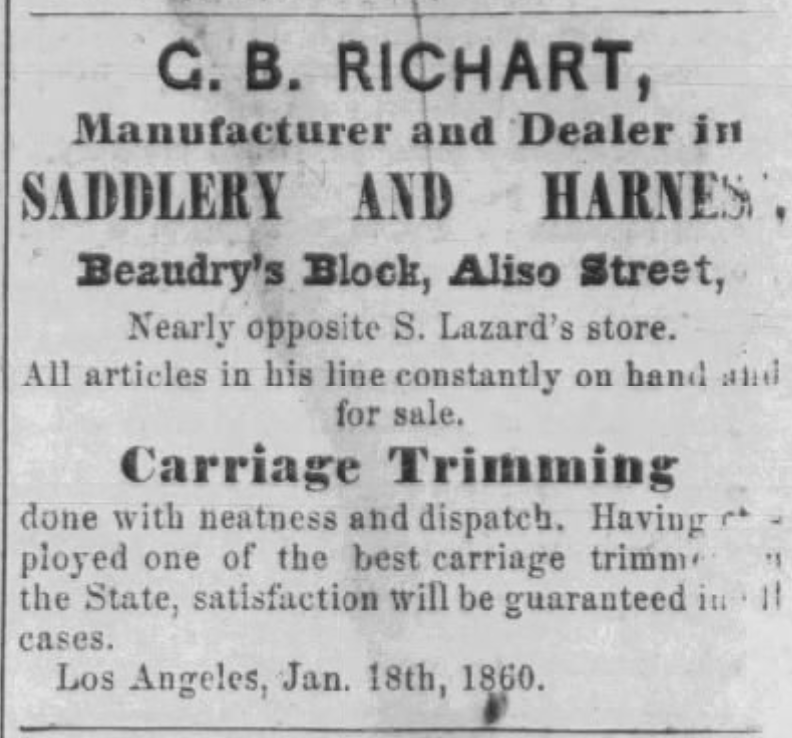Regular readers may already know that Prudent Beaudry owned a commercial building, which his brother Victor remodeled into Southern California's finest business block.
Beaudry's Block (or the Beaudry Block) is long gone; the corner where it stood became part of the 101 long ago. But we can get an idea of what it was like.
At least one source indicated it was originally adobe, but that the original adobe walls were replaced with brick. This was an expensive endeavor for the 1850s, costing $25,000 (about $884,000* today) - and cost more than twice the building's $11,000 price tag!
Newspaper accounts indicate Beaudry's Block had fronts on both Los Angeles Street and Aliso Street, and a map in the Huntington Library collection indicates it was part of a tract he developed. (In a sign of the times, at least one older source gives an address using Los Angeles Street's old name.) Pepper trees were planted outside.
 |
| Beaudry property map, 1863. Courtesy of the Huntington Library |
In this ad, published a few months later, note the frontage on what is now Los Angeles Street. (I should probably also explain "made to order by machinery" here. Sewing machines existed in 1855 but were not widely accepted until the Civil War necessitated making a lot of uniforms very quickly.)
 |
| Ad for machine-made bags, tents, wagon covers, and other heavy-duty fabric items, 1855 |
 |
| Notice of city Marshal's office in Beaudry's Block receiving taxes, 1857 |
Prudent Beaudry expanded his real estate later that year, turning one building into a block of brick buildings (see the map above for how this played out). By October of 1857, it comprised seven storefronts.
 |
| 1857 news blurb describing Beaudry's expansion of the Beaudry Block |
 |
| 1857 news blurb noting completion of the Block |
 |
| 1860 ad for a maker of horse tack and carriage trimming |
 |
| 1860 ad for a new store selling willow ware (i.e. blue willow china), glassware, silver-plate, crockery, etc. The ad refers to the building as "Beaudry's Brick Block". |
This large 1864 newspaper ad, which must have cost a pretty penny even then, advertises Beaudry's own store, taking up several of the Block storefronts. Groceries, alcohol, hardware, clothes, shoes, wagon supplies, crockery, and seeds for grain farming - Beaudry had something for every Civil War-era shopper in Los Angeles. Later ads mentioned doors, window sashes, blinds, cotton seeds, wallpaper, finer ladies' clothing, and sewing machines (which, by 1865, were increasingly desirable household items). Beaudry advertised goods sold "at San Francisco prices", meaning without the hefty markup most of LA's merchants added at the time (having anything shipped to then-remote Los Angeles was expensive).
Beaudry added some special services, too: monthly grain storage for area farmers, and insurance for buildings (whether residential or commercial).
Unfortunately, by 1866 Beaudry announced he was closing up shop and liquidating the store, auctioning off the stock. He had made the mistake of offending Harris Newmark with a comment about his store running Jewish merchants out of business, which prompted Newmark to undercut Beaudry’s pricing. Newmark took a financial hit (from which he recovered), but succeeded in shutting down Beaudry’s store. (As to whether Beaudry was anti-Semitic: he’d probably be canceled for that comment today. Still, he had Jewish tenants and Jewish business partners, and entrusted his poor vision to a Jewish optician. Only Beaudry himself knows for sure, and he’s not talking.)
The Beaudry Block housed at least one French restaurant - La Pension Français.
I hasten to add that he moved his office to 4 Beaudry Terrace in the spring of 1870.
The corner storefront got a new tenant in 1874. Messrs. Serrano and Bilderrain sold clothing, boots, shoes, and dry goods in the space.
In 1891, Prudent Beaudry sold Beaudry's Block to T.D. Stimson, a lumber baron who had recently arrived from Chicago. Stimson was 60 years old, searching for a quieter life out West, and was worth several million dollars - in 1891, that was quite a lot of money. (Read about Stimson's West Adams home here.)
 | ||
1866 ad for Laventhal's clothing, shoe, and dry goods store.
|
By 1869, Beaudry was running his real estate office from Beaudry's Block.
 |
| 1869 ad for Beaudry's real estate business at Beaudry's Block address |
I hasten to add that he moved his office to 4 Beaudry Terrace in the spring of 1870.
 |
| Ad for Eagle Mills grain and livestock feed store, 1872 |
In 1891, Prudent Beaudry sold Beaudry's Block to T.D. Stimson, a lumber baron who had recently arrived from Chicago. Stimson was 60 years old, searching for a quieter life out West, and was worth several million dollars - in 1891, that was quite a lot of money. (Read about Stimson's West Adams home here.)
Stimson must have made some alterations to Beaudry's Block; the 1894 Sanborn Map shows it was no longer a continuous L shape. Los Angeles didn't have a significant earthquake in the 1890s, and brick buildings are less likely to catch on fire, which suggests the changes weren't the result of a natural disaster.
As you can see, the corner that was home to Beaudry's L-shaped Block now housed the Wilcox Block (home to two French hotels), with a 55-foot gap separating the existing buildings from some hay sheds.
 |
| Former site of Beaudry's Block, 1894 |
As you can see, the corner that was home to Beaudry's L-shaped Block now housed the Wilcox Block (home to two French hotels), with a 55-foot gap separating the existing buildings from some hay sheds.
Beaudry had passed away in 1893. I do wonder if his sale of the building had anything to do with it being more or less next to the red-light district.
*The actual cost of remodeling a 19th century adobe into a brick building would likely be higher today due to California's strict building codes. I hasten to add that I hope no one ever actually replaces a surviving 19th century adobe with a brick building in the 21st century - there aren't that many of them left.








